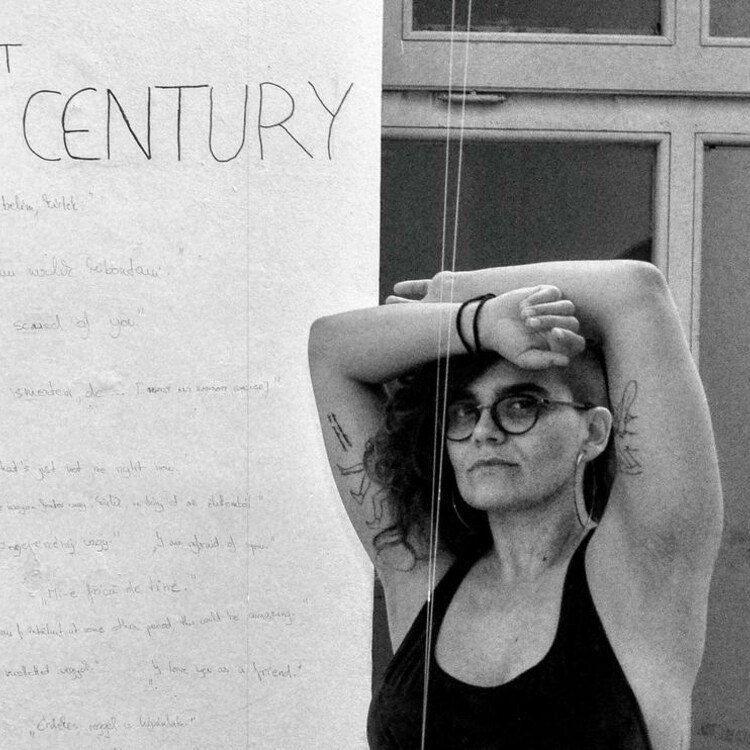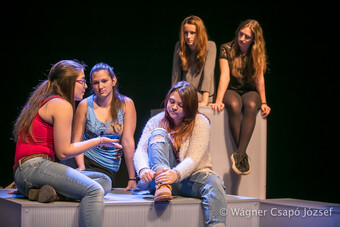Periphery as Center
the Independents from Budapest / A periféria mint központ. Budapesti függetlenek
There is a picture that had been presented to the outside world from Budapest, Hungary for the past five years: a professional scene whose resources became limited due to governmental changes; organizations and works of art being ended for political reasons; artistic freedom and free speech being harmed. And there are several voices, a canon, who were presented in this context: Árpád Schilling, Kornél Mundruczó, Béla Pintér, Róbert Alföldi, and others.
The questions we would like to ask and debate in this series are: who are those who were already on the periphery before all this happened, and where are they now? How do they see this aforementioned picture, and what did it bring for them? What else is there to say or do; what tools are we giving to the next generation this way? In the first post of the series, Budapest-based curator and theatre critic Anikó Varga gives us an overview of the young independent theatre field from the capital.—Zenkő Bogdán, series curator.
The following text was translated from Hungarian by Panna Adorjáni.
As a critic I often find myself in a situation where friends not well acquainted with theatre ask for my advice on what they should see. Although one should recommend according to the interests of the person who asked, I always find myself listing mostly independent productions. This is no accident, as this also represents my scope of interest: progressive, innovative contemporary theatre is typically found in this part of the theatre spectrum, even if many of the artists work in both small workshops and in state-subsidized theatres. Viktor Bodó, Kornél Mundruczó, Béla Pintér, and Árpád Schilling are already household names of international theatre. But who resides beyond the front lines of the renowned names? Who are the independents and why are they independent? What is the situation for the young artists who, upon graduating, seek to make a career in theatre other than the state-subsidized production system, or who want to establish a company that does not fit into the grand aesthetics of repertory theatre?

The Hungarian independent theatre historically fits into the tradition of the experimental neo-avantgarde, which has always been regarded as part of the counter-culture opposing the all-time political power, an art scene that had its space even in the Kádár era, due to the “permissive” cultural policies of regime—as opposed to other Eastern European countries of the region, such as Romania, where strict censorship basically made impossible all organizations outside the institution. After the changes of ’89, the Hungarian independents established themselves around this heritage and went on to form several companies, to create forums for presenting their productions, and to organize festivals. In 2008, they became the eminent part of the state-subsidy system, when the new Performing Arts Statute guaranteed them 10 percent of the subsidy of the theatres funded by the municipalities. This ruling, albeit with a short life, strengthened the lives of small workshops and helped in enhancing their prestige. It shows the lack of consensus regarding the protection of interests of Hungarian professional entities. The law was rewritten less than two years later, with the new version from 2011 not only missing the 10 percent guarantee but also featuring a new category system of theatres and various administrative obstacles in the granting process, which meant that the possibility of a more or less safe, consistent growth of the companies was destroyed. The consequences became quickly visible: the sum the independents could apply for has been cut down to a quarter since 2010, and this resulted in the termination or shrinking of many companies. In this general process of atrophy, the negative changes in the realms or cultural policies had also played a role: hosting venues ceased their operation, the network of alternate financial resources consisting of foundations and philanthropic individuals also degraded. The venues that first halted their operations were the ones seen as the second step for creators (the role of Sirály, Fogasház, or Hátsó Kapu today is partly taken over by Auróra or Patyolat), where smaller groups had the possibility to experiment with more radical performances or with productions that were aimed for a narrower stratum of spectators, where they could gain experiences before continuing on to the bigger venues, such as Trafó, Jurányi, Szkéné, or Mu Theatre.
What is the situation for the young artists who, upon graduating, seek to make a career in theatre other than the state-subsidized production system, or who want to establish a company that does not fit into the grand aesthetics of repertory theatre?
Although one can say that space available to independents is constantly shrinking, as are their possibilities for creation, this medium is still open to cross-genres, performative aesthetics or community theatre as opposed to the traditional theatrical ideal that is mostly concerned with drama and that views its productions belonging to rigid concepts of genre. It is the representatives of this spectrum that are renowned internationally, although at home the centers of contemporary performing arts (their companies, the artists, and the hosting venues) live on the periphery. They are peripheral even in terms of the canon, the subsidy, the representation, and the general taste: POSZT, the most important festival representing Hungarian theatre, hardly ever features independent productions in its competition program, as these works have nothing to do with the notion of the radically conservative national theatre ideal.
Because of the expectation/pressure to produce, the hosting venues in Budapest partly function in a similar way: they try to share and rotate between each other the performances of independent companies, also keeping in mind their own profile and image. Trafó House of Contemporary Arts is the most representative. Their mentality is characterized by their aim to present high quality contemporary and experimental artistic works both on a national and on an international level: theatre, dance, nouveau cirque, puppet theatre, music, concert performance, and literary events. Jurányi Incubator House also plays a prominent role: this former school building became the basis for many independent companies and artists, as they provide both rehearsal space and a studio. MU Theatre is orientated toward contemporary dance, community theatre, and theatre in education (KÁVA is based here), next to Szkéné—home of many powerful companies since the changes in ‘89 and a venue that is still the host for the companies of Béla Pintér and Csaba Horváth—and Átrium, that also provide spaces for performing. Central Europe Dance Theatre is especially interested in contemporary dance productions and emerging artists, while SÍN Culture Centre also focuses on talent management in contemporary dance, providing both rehearsal space and producing partnerships. This network is basically also the organizer of independent festivals: next to Nextfest by Trafó and the dunaPart showcase, the international festival, Thealter from Szeged is the only one willing to make up for the alarming lack of contemporary theatre in the canon of the big festivals.
Why are these places so important? Firstly, because they function as workshops, which is something the subsidized theatres’ production system can almost never offer and which is also the basis for the birth and time-consuming refinement of distinct theatre languages. Next to the visions of Mundruczó, Schilling, Pintér, or Bodó, we could also mention the physical theatre of Csaba Horváth and his Forte Company that combines movement, image, and spoken word, or the improvisational theatre of Péter Kárpáti and his Secret Company whose method was developed through years of work, but also Tamás Ördög and his company called dollardaddy’s, a newer generation of creators who experiment with everyday, common methods of expression in their drama transcripts or Adrienn Hód’s compellingly dense dance performances that address issues related to the presence, the body, and the identity of the contemporary performer. And so on, we could mention further artists and flexible groups who all add greatly not only to the variability of the independent theatrical sphere but also to a generational and cultural continuity which is the requisite for the formation of relevant works and aesthetic languages.
Within the Central and Eastern European socio-cultural context, all this is not doable without state subsidy, which is getting more and more restricted. Those young and emerging artists who would like to strive outside the established structure have to face their limited possibility in getting subventions and find creative solutions for the sustainability of their own, independent career. They have to take into account an industry stridently severed by politics; the process of leveling that, albeit gently, can bring closer the hosting companies and the state subsidized theatres in terms of financials and of operating in the repertory system; the pressure of ceaseless producing that is needed for constant visibility; and, naturally, all of the existential consequences: today an independent theatre artists in Budapest can and will have to make a living from other types of works, typically offered by the state subsidized theatres.
***
Az elmúlt öt évben kialakult egy kép a külvilágban Budapestről, Magyarországról: egy, a kormányváltás miatt egyre korlátozottabb forrásokból létező szakmai közeg; politikai okok miatt megszűnő szervezetek és félbemaradó művészeti alkotások; a szólás és alkotói szabadság folyamatos megsértése. És ebben a kontextusban megszólalt több hang, egy kánon: Schilling Árpád, Mundruczó Kornél, Pintér Béla, Alföldi Róbert stb.
Kik azok, akik mindezek előtt is a periférián voltak és hol vannak most? Hogyan látják ők a fentiekben leírt helyzetet és mit hozott számukra? Mit lehet még mondani vagy tenni? Milyen eszközöket adunk a jövő generáció kezébe ily módón? - ezek a kérdések, amelyeket fel szeretnénk tenni és megvitatni ebben a sorozatban. A sorozat első posztjában Varga Anikó, a Budapesten élő kurátor és színházi kritikus, a fővárosi, független, fiatal szcénát mutatja be.—Zenkő Bogdán
Kritikusként sokszor kerülök abba a helyzetbe, hogy szakmán kívüli ismerősök és barátok, akik nem követik szorosan, mi zajlik a budapesti színházakban, tanácsot kérnek, mit érdemes megnézniük. Javasolni természetesen a kérdezők érdeklődésének megfelelően szokás, mégis többnyire független produkciók felsorolásánál kötök ki ilyenkor, és nem véletlenül, vagy pusztán a magam érdeklődése miatt: ami manapság progresszív, innovatív kortárs színházi alkotást jelent, jellemzően ehhez a szférához köthető; akkor is, ha az alkotók tekintetében számos átfedés akad példa a kis műhelyek és kőszínházak között. Bodó Viktor, Mundruczó Kornél, Pintér Béla vagy Schilling Árpád nevét sokan ismerik nemzetközi szinten. De kik vannak az ismertebb nevek frontvonalán túl? Kik a függetlenek és mitől függetlenek? Egyáltalán: milyen helyzetben vannak ma azok a fiatal alkotók, akik a színházi képzés végeztével a kőszínházi produkciós gyakorlattól eltérő körülmények közt szeretnék megvalósítani magukat – vagy csak olyan színházat létrehozni, amely nem fér bele a nagy, repertoár-színházi esztétikák kereteibe?
A magyarországi független színház történetileg a neoavantgárd kísérleti hagyományába illeszkedik, amelynek a mindenkori hatalommal szemben fellépő ellenművészetként – a környező Kelet-Európai országokhoz, pl. Romániához képest, ahol a szigorú cenzurális gyakorlatilag ellehetetlenítette az intézményen kívüli szerveződést – a kádár kori „megengedő” kultúrpolitika következtében is volt tere. A 89-es rendszerváltás után a magyar független szféra ennek az örökségnek a mentén szervezte meg magát számos társulattal, a produkcióikat közvetítő fórumokkal és fesztivállal. Ez a szegmens 2008-ban került az állami finanszírozás tekintetében kiemelt helyzetbe: az ekkor megalkotott előadó-művészeti törvény garantálta számukra az önkormányzati színházak állami támogatásának 10%-át. A rendelkezés, amely egzisztenciálisan megerősítette a kis műhelyeket és növelte szakmai presztízsüket, azonban nem sokáig maradt érvényben. A magyarországi szakmai szervezetek érdekérvényesítő konszenzusának hiányát jól jelzi, hogy az alig két évvel később, 2011-ben újraírt törvény nem csak a 10%-os garanciát törölte el, de átalakítva a színházi besorolás kategóriáit, és adminisztratív akadályokkal nehezítve a pályázást felszámolta a többé-kevésbé biztonságos, következetes építkezés lehetőségét. A következmények gyorsan megmutatkoztak: 2010 óta negyedére csökkent a függetlenek által megpályázható összeg, ami maga után vonta több társulat megszűnését vagy összezsugorodását. Az általános sorvadási folyamatban a szélesebb kultúrpolitikai téren zajló negatív változások is közrejátszottak: befogadóhelyek szűntek meg, az állami finanszírozási lehetőségek mellett jelentősen leépült az egyéb gazdasági forrásokat jelentő – alapítványokból és adományozó magánszemélyekből álló – hálózat. S ezzel együtt pont azok a köztes lépcsőfokok estek ki – pl. a volt Sirály, Fogasház, Hátsó Kapu, amelyek szerepét némileg az Auróra vagy Patyolat vették át –, ahol az induló kisebb csoportok kipróbálhatták magukat az akár radikálisabb, szűkebb közönséget megszólító előadásaikkal, tapasztalatot szerezve, mielőtt továbbléptek volna a bejáratottabb és nagyobb helyekre, mint a Trafó, Jurányi, Szkéné vagy Mu Színház.
Miközben elmondható, hogy a függetlenek élettere egyre szűkül, és ezzel együtt az alkotási lehetőségeik, Budapesten ez közeg az, amely a műfajilag mereven tagolt és az elsősorban drámairodalmat reprezentáló hagyományos színházeszmény dominanciája mellett a műfajköziségre nyitott, performatív esztétikáknak, ill. közösségi színházi gondolkodás platformja. S miközben nemzetközi színtéren főként e szegmens képviselői ismertek, addig elmondható, hogy hazai szinten a kortárs előadó-művészet centrumai – társulatai, alkotói és befogadóhelyei – az intézményes periférián lelhetők fel. Kánon, támogatottság, reprezentáció, közízlés szempontjából is a széleken: a magyar színházak legfontosabb fesztiválja, a POSZT hivatalos versenyprogramjába például alig kerül be független produkció, a nemzeti színház eszményének radikálisan konzervatív elképzelésében nincsen számukra hely.
A budapesti befogadóhelyek a produkciós elvárás/kényszer miatt részben hasonlóan működnek, megosztva és rotálva egymás közt a független társulatok előadásait, részben igyekeznek saját profilt, arculatot kialakítani. A Trafó Kortárs Művészetek Háza ezek közül a legmarkánsabb, amelynek szellemiségét a legjellemzőbb, hogy a magas minőségű kortárs-kísérleti művészeti formákat a nemzetközi és hazai kontextust illetően is egy keretbe rendezi: színházat, táncot, újcirkuszt, bábszínházat, zenét, koncertszínházat, irodalmi eseményeket egyaránt kínálva. Mellette lényeges szerep jut a Jurányi Inkubátorháznak: a volt iskolából átalakított központ nagyszámú független társulat és alkotó bázisa, próbatermet és fellépési lehetőséget biztosít nekik. A MU Színház főként a kortárs tánc és közösségi, illetve nevelési színház felé orientálódik (pl. itt található a KÁVA székhelye), a Szkéné mellett, amely a rendszerváltás óta jelentős társulatokat indított útjukra, és amely Pintér Béla és Horváth Csaba társulatainak székhelye, az Átrium kínál még fellépési lehetőséget. A Közép-Európa Táncszínház kimondottan a kortárs táncszínházi produkciókra és a karrierjük elején álló alkotókra fókuszál és ugyanígy kiemelt intézménye a kortárs táncos tehetséggondozásnak a Sín Kulturális Központ, amely próbateremre és produkciós partnerségre ad lehetőséget. Gyakorlatilag ez az a hálózat, amely fesztiválokat szervez a függetleneknek: a Trafó Nextfesztje és dunaPart showcase-e mellett a szegedi Thealter Nemzetközi Fesztivál korrigálja a hazai nagy fesztiválok kortárs színházat riasztóan mellőző kánonját.
De miért is fontosak ezek a helyek? Mindenekelőtt a műhelyfunkció miatt, amit a kőszínházak termelési rendszere igen kevéssé tud nyújtani, és ami esztétikai értelemben alapfeltétele egy-egy sajátos színházi nyelvezet megszületésének, időigényes kicsiszolódásának. Mundruczó, Schilling, Pintér vagy Bodó látásmódja mellett említhetnénk erre példaként a Horváth Csaba által vezetett Forte Társulat mozgást, képet és beszédet egységgé komponáló fizikai színházát, a Kárpáti Péter vezette Titkos Társulat improvizációs színházát, amelynek módszere több éves folyamat során alakult ki, a fiatalabb generációban az Ördög Tamás nevével fémjelzett Dollár Papa Gyermekeit, amely drámaátirataiban a mindennapi-közvetlen megszólalási módokkal kísérletezik, vagy Hód Adrienn lenyűgözően sűrű, a kortárs performeri jelenlét, test és identitás problémáit színre vivő táncszínházát. És számos egyéb alkotót, képlékeny formációt, akikre hely hiányában ugyan nem térek ki, de akik munkásságukkal egytől-egyig hozzájárulnak nem csak a független színházi közeg variabilitásához, de ahhoz a generációs és kulturális folyamatossághoz is, amely egyáltalán lehetővé teszi az igen jelentős alkotások, formanyelvek megszületését.
A közép- és keleteurópai kulturális viszonyok közt mindez nem tűnik fenntarthatónak állami szubvenció nélkül, és ennek – úgy tűnik, egyre korlátosabb – adottságaival kell számolnunk. Annak, aki ma fiatal alkotóként a kőszínházakon kívül keresi az útját, arra kell kreatív választ adnia, hogy miként fenntartható egy független alkotói pálya. Számot kell vetnie a politikum mentén élesen megosztott színházi szakmával, a nivellációs folyamattal, ami a befogadóhelyek és kőszínházak intézményeit a repertoárszerű működésben gazdasági alapon finoman, de egymáshoz közelítik, az állandó jelenlétet biztosító termelési kényszerrel, és persze mindezek egzisztenciális hozadékával: hiszen független előadó-művészként ma Budapesten másból kell, lehet megélni, jellemzően a kőszínházi munkák vállalásaiból.










Comments
The article is just the start of the conversation—we want to know what you think about this subject, too! HowlRound is a space for knowledge-sharing, and we welcome spirited, thoughtful, and on-topic dialogue. Find our full comments policy here